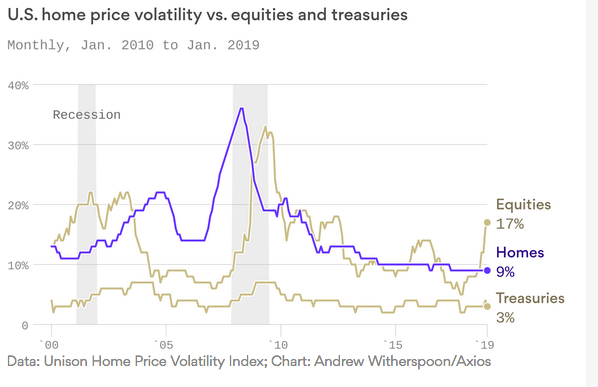What City Observatory did this week
Homeownership is frequently a bad bet. Although homeownership gets treated as the best way to built wealth, it’s actually a highly risky financial strategy for many households, especially those with modest incomes. It turns out that buying a home is a highly leveraged, and non-diversified investment that exposes the buyer to considerable risk. New data shows that in any given five year period, there’s about a 30 percent chance that a home will experience a decline in value, which can wipe out a families investment if it has to sell.
Must read
1. What if a big coastal city with a thriving economy built lots of apartments? Look no further than Sydney, where the market has been building apartments with reckless abandon. Tens of thousands of new apartments have been finished, more are in the pipeline, and rents are down as much as $100 a month, and vacancies are still rising. The Sydney Morning Herald reports:
Sydney is in the grip of an apartment building boom, with 30,880 multi-unit dwellings built last year, a record for any Australian city. There were 16 multi-unit projects finished in the first three months of 2019, adding another 1948 units.
Sydney has a pipeline of 194,000 multi-unit dwellings at various stages of development, a report by the Urban Development Institute of Australia (UDIA) shows. These numbers are flowing through Domain.com.au, where 17,500 units were listed for rent in June 2017, and ballooned to 32,680 listings in June 2019. The result has been landlords asking for $25 a week less median rent than last year.
Who says you can build your way to lower rents: If you build enough apartments, rents will fall. The problem is US cities seldom encourage (much less allow) this kind of irrational exuberance that works to the benefit of a city’s renters. (Hat tip to Market Urbanism)
2. Free-park-and-ride lots at transit stops are evil. Sightline’s Michael Andersen makes a compelling case that the standard US practice of surrounding major transit stops with acres (or floors) of free parking is actually a clever plot by super-villains aiming to destroy transit systems. Seattle’s King County Metro is considering whether to start charging for use of its Northgate parking lot, which generally tends to be full at 7am. As a result, those who come later in the day find no parking (even if they would gladly pay for it), and other riders queue up or take earlier buses to be sure they get a “free” spot. And, by everything that’s Shoup, we know that parking isn’t free; it costs the transit agency tons to build and maintain parking lots, and the money spent on that, can’t be used to run buses, with the result that those who don’t use the park and ride pay for it twice: through the money that supports it and through lousier transit service.
the parking garages you build are massive money-losers that every user of your system will have to pay for in the form of less frequent, less reliable transit service
Parking is a valuable premium service. Charging users the actual price of providing it is a better way to allocate the parking, and a fairer and more efficient way to run a transit system.
3. Why integration matters. The New York Times Thomas Edsall uses the recent resurfacing of the busing controversies of past decades to explore the logic, merits and obstacles to integration. His column presents a powerful summary of research showing the striking benefits of living in more integrated communities:
There is a large body of evidence that shows that African-American children perform better when they move out of high-poverty areas into more middle class, less segregated neighborhoods. Academic achievement improves, college completion rates go up, arrests go down, unwed parenthood declines and employment rates go up, with better pay.
In addition, these same studies show the gains for students of color don’t come at the expense of white children. Edsall also explores the tight relationship between housing segregation and school segregation. The experts Edsall interviews have a range of opinions, from pessimistic to optimistic as to whether the nation is likely to make progress in promoting further integration, but there’s general agreement that it matters greatly to the nation’s future well-being and to reducing persistent inequality.
In the News
In an editorial asking “Is Zoning a Promise,” the CT Examiner quotes City Observatory’s observation that there’s an inherent contradiction between public policy goals of promoting housing affordability and treating homeownership as a wealth-building strategy.
Highway advocates use the same phony claims around the world it seems. In an article entitled “Axing the Silvertown Tunnel,” The Ecologist (a UK publication), cited our myth-busting of the oft-repeated claim that road widening to reduce car idling in traffic will reduce CO2 emissions (expanding capacity induces added traffic that actually increases emissions.)



